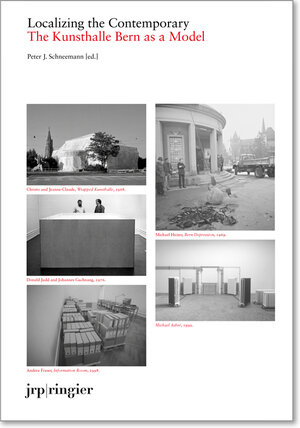
×
![Buchcover ISBN 9783037645284]()
Localizing the Contemporary
The Kunsthalle Bern as a Model
von Kari Conte und weiteren, herausgegeben von Peter J. SchneemannLocalizing the Contemporary
The format of the Kunsthalle as a specific place for the production and exhibition of contemporary art is the main focus of this theoretical publication. In contrast to collecting museums, the Kunsthalle is associated with concepts of artistic freedom and novelty. Taking into account this dynamism, the book understands the Kunsthalle as a model that contributes to the formation of contemporary art in essential ways. The Kunsthalle Bern, its historical development, the political implications of its exhibitions, as well as its societal positioning is thereby a key institution to discuss, analyze, and understand the Kunsthalle format on a more abstract level.
Edited by Bern’s Institut für Kunstgeschichte Professor Peter J. Schneemann, and published on the occasion of the centenary of the Kunsthalle Bern, this publication gathers together 18 essays about the Kunsthalle Bern as a role model and a place for artistic intervention and production, elaborating the examinations to which numerous international artists have subjected the building itself. Interventions in the architectural structure of the Kunsthalle Bern have led to a constant and critical exploration of both the institution and its building.
Structured into three main sections, this anthology discusses the Kunsthalle Bern as a model where the contemporary can be localized. Thus, the book aims to contribute to current research on institutional histories. International authors from a broad range of institutions and professional fields examine the Kunsthalle’s role as a curatorial field of experimentation, as artistic material, and as a platform for transatlantic exchange. With contributions by Kari Conte, Damian Lentini, Susanne Neubauer, Glenn Phillips, Hans Rudolf Reust, Terry Smith, Beatrice von Bismarck, and many more.
The format of the Kunsthalle as a specific place for the production and exhibition of contemporary art is the main focus of this theoretical publication. In contrast to collecting museums, the Kunsthalle is associated with concepts of artistic freedom and novelty. Taking into account this dynamism, the book understands the Kunsthalle as a model that contributes to the formation of contemporary art in essential ways. The Kunsthalle Bern, its historical development, the political implications of its exhibitions, as well as its societal positioning is thereby a key institution to discuss, analyze, and understand the Kunsthalle format on a more abstract level.
Edited by Bern’s Institut für Kunstgeschichte Professor Peter J. Schneemann, and published on the occasion of the centenary of the Kunsthalle Bern, this publication gathers together 18 essays about the Kunsthalle Bern as a role model and a place for artistic intervention and production, elaborating the examinations to which numerous international artists have subjected the building itself. Interventions in the architectural structure of the Kunsthalle Bern have led to a constant and critical exploration of both the institution and its building.
Structured into three main sections, this anthology discusses the Kunsthalle Bern as a model where the contemporary can be localized. Thus, the book aims to contribute to current research on institutional histories. International authors from a broad range of institutions and professional fields examine the Kunsthalle’s role as a curatorial field of experimentation, as artistic material, and as a platform for transatlantic exchange. With contributions by Kari Conte, Damian Lentini, Susanne Neubauer, Glenn Phillips, Hans Rudolf Reust, Terry Smith, Beatrice von Bismarck, and many more.


